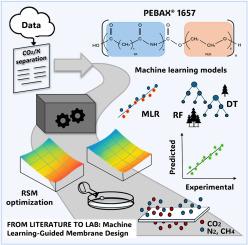Membrane preparation assisted by integration of machine learning and response surface methodology for CO2 separation
IF 9
1区 工程技术
Q1 ENGINEERING, CHEMICAL
引用次数: 0
Abstract
The separation of carbon dioxide (CO2) is presented as a current challenge in the environment and energy sector. The primary reason for this is to control the emissions of this gas into the atmosphere and the upgrading of biomethane. In this context, the membrane separation technology seems to be a very sustainable promising tool for such tasks. This work presents a machine learning (ML) study, based on a database created from membrane preparation conditions and gas separation records from the literature, achieved for the CO2/N2 and CO2/CH4 mixtures using dense membranes of thermoplastic elastomer Pebax® 1657. A comparative analysis of three different ML models was carried out: multiple linear regression, decision tree and random forest. This last algorithm demonstrates the best performance in statistics terms of coefficient of determination and root mean square error. In addition, the combination of the ML random forest with a method based on the design of experiments with response surface methodology (RSM) allowed to identify the favorable conditions for the membrane synthesis, with the objective of enhancing the CO2 separation performance. This resulted in prepared membranes in the laboratory considering the proposed conditions by RSM with CO2 permeability and CO2/X selectivity values of 115 Barrer and 43.5 and 132 Barrer and 16.4 for the CO2/N2 and CO2/CH4 mixtures, respectively, at 35 °C.

基于机器学习和响应面方法的CO2分离膜制备
二氧化碳(CO2)的分离是当前环境和能源部门面临的一个挑战。这样做的主要原因是为了控制这种气体向大气中的排放和生物甲烷的升级。在这种背景下,膜分离技术似乎是一种非常可持续的有前途的工具。这项工作提出了一项机器学习(ML)研究,该研究基于基于膜制备条件和文献中气体分离记录创建的数据库,实现了使用热塑性弹性体Pebax®1657致密膜的CO2/N2和CO2/CH4混合物。对多元线性回归、决策树和随机森林三种不同的机器学习模型进行了比较分析。最后一种算法在统计决定系数和均方根误差方面表现出最好的性能。此外,将ML随机森林与基于响应面法(RSM)实验设计的方法相结合,可以确定膜合成的有利条件,以提高CO2分离性能。这导致在实验室中制备的膜考虑了RSM提出的条件,在35°C下,CO2/N2和CO2/CH4混合物的CO2渗透率和CO2/X选择性值分别为115 Barrer和43.5,132 Barrer和16.4。
本文章由计算机程序翻译,如有差异,请以英文原文为准。
求助全文
约1分钟内获得全文
求助全文
来源期刊

Journal of Membrane Science
工程技术-高分子科学
CiteScore
17.10
自引率
17.90%
发文量
1031
审稿时长
2.5 months
期刊介绍:
The Journal of Membrane Science is a publication that focuses on membrane systems and is aimed at academic and industrial chemists, chemical engineers, materials scientists, and membranologists. It publishes original research and reviews on various aspects of membrane transport, membrane formation/structure, fouling, module/process design, and processes/applications. The journal primarily focuses on the structure, function, and performance of non-biological membranes but also includes papers that relate to biological membranes. The Journal of Membrane Science publishes Full Text Papers, State-of-the-Art Reviews, Letters to the Editor, and Perspectives.
 求助内容:
求助内容: 应助结果提醒方式:
应助结果提醒方式:


